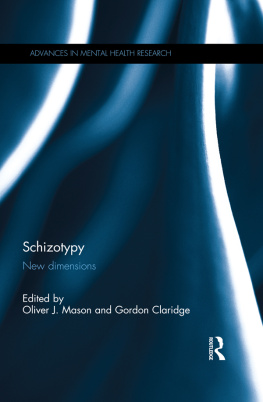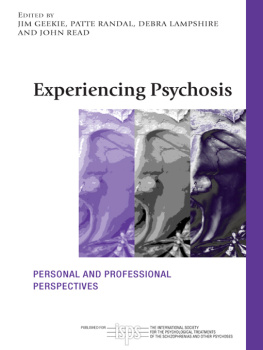First published 2015
by Routledge
27 Church Road, Hove, East Sussex, BN3 2FA
and by Routledge
711 Third Avenue, New York, NY 10017
Routledge is an imprint of the Taylor & Francis Group, an informa business
2015 O. Mason and G. Claridge
The right of the editors to be identified as the authors of the editorial material, and of the authors for their individual chapters, has been asserted in accordance with sections 77 and 78 of the Copyright, Designs and Patents Act 1988.
All rights reserved. No part of this book may be reprinted or reproduced or utilised in any form or by any electronic, mechanical, or other means, now known or hereafter invented, including photocopying and recording, or in any information storage or retrieval system, without permission in writing from the publishers.
Trademark notice: Product or corporate names may be trademarks or registered trademarks, and are used only for identification and explanation without intent to infringe.
British Library Cataloguing in Publication Data
A catalogue record for this book is available from the British Library
Library of Congress Cataloging in Publication Data
Schizotypy (Mason)
Schizotypy : new dimensions / edited by Oliver Mason and
Gordon Claridge.
p. ; cm.
Includes bibliographical references and index.
I. Mason, Oliver, 1967- , editor. II. Claridge, Gordon, 1932- , editor.
III. Title.
[DNLM: 1. Schizotypal Personality Disorder. 2. Schizophrenic
Psychology. WM 203]
RC569.5.S36
616.8581dc23
2014046166
ISBN: 978-0-415-72203-2 (hbk)
ISBN: 978-1-315-85856-2 (ebk)
Typeset in ITC New Baskerville Std
by Swales & Willis Ltd, Exeter, Devon, UK

Advances in Mental Health Research series
Books in this series:
The Clinical Effectiveness of Neurolinguistic Programming
A critical appraisal
Edited by Lisa Wake, Richard M. Gray and Frank S. Bourke
Group Therapy for Adults with Severe Mental Illness
Adapting the Tavistock method
Diana Semmelhack, Larry Ende and Clive Hazell
Narratives of Art Practice and Mental Wellbeing
Reparation and connection
Olivia Sagan
Video and Filmmaking as Psychotherapy
Research and practice
Edited by Joshua L. Cohen and J. Lauren Johnson with Penelope P. Orr
Schizotypy
New dimensions
Edited by Oliver J. Mason and Gordon Claridge

Contents
OLIVER J. MASON AND GORDON CLARIDGE
THOMAS R. KWAPIL AND CHARLOTTE A. CHUN
CHRISTINE MOHR AND ULRICH ETTINGER
PHILIP GRANT
GINA M. GRIMSHAW AND LAURA KRANZ
MARTIN DEBBAN
TJASA VELIKONJA, OLIVER J. MASON AND HELEN L. FISHER
TAMARA SHEINBAUM AND NEUS BARRANTES-VIDAL
EMMA BARKUS
CHRISTINA DANIEL AND OLIVER J. MASON
CHARLIE HERIOT-MAITLAND AND EMMANUELLE PETERS
JO HODGEKINS
NICOLA J. HOLT
GORDON CLARIDGE
Part I
Measurement, brain and biology
Part III
Consequences and outcomes
7
Mechanisms mediating the pathway from environmental adversity to psychosis proneness
Tamara Sheinbaum and Neus Barrantes-Vidal
Introduction
A fast-growing field of research investigating the effects of psychosocial adversity on the brain is challenging the view that the endophenotypic abnormalities found in schizotypy and schizotypal personality disorder (SPD) only derive from genetic and biological insults for instance, early life maltreatment impairs brain structure and physiology (e.g. Teicher, Anderson, Ohashi, & Polcari, 2013). Notably, animal models (e.g. of maternal separation) suggest that these exposures cause brain and behavioural phenotypes that are analagous to those observed in individuals with schizophrenia (Brown, 2011).
Epidemiological research has recently shown an association of psychosocial factors both at macro (i.e. social) and micro (i.e. personal) environmental levels with clinical and non-clinical psychosis, particularly for the dimension of reality distortion (reviews in Bentall & Fernyhough, 2008; Brown, 2011). Some studies are conflicting, but there is an increasing consensus that psychosocial adversity is not merely a trigger of a genetically based psychosis proneness, but rather a co-participating factor in the make-up of the diathesis to psychosis. Velikonja, Mason, & Fisher ( in this volume) have reviewed in depth the relation of schizotypy with maltreatment, parental loss and bullying. In this chapter, we will first provide a brief overview of the array of candidate psychosocial factors that have been associated with schizotypy, and then focus on the mediating mechanisms that have received most attention in accounting for the adversityschizotypy connection.
Macro-environmental risk factors
Urbanicity
An increasing body of evidence indicates that early exposure to an urban environment is associated with both subclinical and clinical psychosis (Krabbendam & van Os, 2005). Studies have demonstrated a dose-response effect of urbanicity on psychotic-like experiences (PLEs) (van Os, Hanssen, Bijl, & Vollebergh, 2001) and that the persistence of PLEs is greater among those living in an urban as opposed to a rural area (Spauwen, Krabbendam, Lieb, Wittchen, & van Os, 2006).
Poverty
Poverty seems to be more strongly related to psychosis than to other psychiatric conditions (Read, 2010). A Swiss general population survey that assessed all DSM-IV (American Psychiatric Association, 2000) personality disorders found that poverty was uniquely associated with SPD ratings (Hengartner, Ajdacic-Gross, Rodgers, Mller, & Rssler, 2013). Additionally, other general population studies have provided evidence that socio-economic disadvantage (variously defined) is associated with a greater likelihood of reporting PLEs (e.g. Saha, Scott, Varghese, & McGrath, 2013).
Minority status
Evidence suggests that both first- and second-generation immigrants have an increased risk for developing psychosis (Bourque, van der Ven, & Malla, 2011), and that migrant status is associated with a greater prevalence of PLEs (van Os, Linscott, Myin-Germeys, Delespaul, & Krabbendam, 2009). According to van Os (2012), several pieces of evidence (including the fact that the risk for psychosis persists into the second generation and is also found in ethnic minorities without recent history of migration) suggest that it is not migration in itself that elevates psychosis proneness, but rather certain features of the greater social context in the host country, particularly the situation of being in a minority group position. In this respect, research examining the rates of psychotic disorders among ethnic minority individuals has shown that the rates increase as the proportion of the own ethnic group in the neighbourhood of residence decreases (e.g. Boydell et al., 2001). Although studies focusing on ethnic density and psychosis proneness are scarce, a nationally representative study in the UK indicated that, as a whole, ethnic minorities living in a lower own-group density neighbourhood were more likely to endorse PLEs (Das-Munshi et al., 2012).
Micro-environmental risk factors
Family environment
There is evidence linking family environment variables, such as parental communication deviance and expressed emotion, with the risk and course of psychotic disorders. Certain aspects of the family milieu have been associated with PLEs. For example, children with psychotic symptoms are more likely to have mothers with negative expressed emotion, but not decreased warmth (Polanczyk et al., 2010), and individuals high on social anhedonia report less cohesive and more conflictive family environments than controls (Blanchard, Collins, Aghevli, Leung, & Cohen, 2011).













